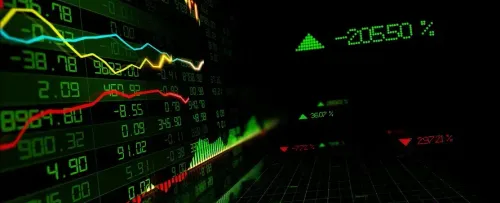
Contracts for Difference (CFDs) are financial derivatives offered by a CFD broker that let you speculate on asset price movements without actually owning the underlying asset.
A CFD allows you to speculate on both rising and falling markets without owning the underlying asset. Profits and losses depend on market movements.
CFDs are traded as standardized contracts on various financial markets, providing flexibility to access shares, indices, commodities, and forex.
When you trade CFDs, you enter into an agreement with your broker to exchange the difference in an asset’s price from when you open to when you close your position. Your profit or loss is determined by the movement in the asset's price.
SeacrestMarkets stands out in the CFD space and operates as a Financial Sector Conduct Authority (FSCA) regulated broker, giving South African traders access to CFD trading with competitive spreads and proper regulatory oversight.
What Exactly Is CFD Trading?
Think of CFD trading as making a deal with your broker about which direction an asset’s price will move. You can buy or sell contracts depending on your market view. You’re not buying Apple shares or gold bars.
Instead, you’re entering a contract based on the price movement of the underlying asset, and the contract’s value is determined by the underlying price—whether Apple’s share price or gold’s price goes up or down.
The fundamental difference between CFD trading and traditional investing comes down to ownership. When you buy traditional shares, you own part of a company, which can lead to potential profits through dividends and capital appreciation. You might get dividends, voting rights, and you’re exposed to the company’s long-term success or failure. With CFDs, you’re purely speculating on short-term price movements.
CFDs also offer something else traditional share ownership doesn’t—the ability to profit from falling prices. Going long means you expect prices to rise. Going short means you expect them to fall. This flexibility attracts many traders because you can potentially make money in any market condition.
CFDs allow you to speculate on rising or falling markets, but success depends on market direction and trading skill. CFDs offer the flexibility to speculate in various market conditions. However, success requires a sound strategy and carries financial risk.
SeacrestMarkets provides access to over 175 forex pairs, plus shares, indices, commodities, and cryptocurrencies. That’s a lot of markets to choose from, which brings us to both the opportunity and the problem with CFD trading - there’s almost too much choice.
So, having said that, what does this actually mean for you as a trader in the financial markets?
How CFD Trading Works
Let’s break down the mechanics because understanding how CFDs actually work can save you from costly mistakes later. To understand how CFD trading works, you need to know the process of opening and closing positions, and how your exposure is determined by the contract size rather than owning the underlying asset.
When you enter a CFD trade, you’ll see two prices:
- 1.
The buy price (also called the asking price)
- 2.
The sell price (also called the bid price)
The difference between the two is the spread, which is basically what the broker charges you for facilitating the trade. Each of these transactions is known as a CFD trade, allowing you to speculate on price movements without owning the actual asset.
Seacrest offers spreads as low as 0.0 pips, which really makes a big difference—especially if you trade frequently.
Leverage can amplify both profits and losses. Used responsibly, it offers greater market exposure. However, it increases your risk, and losses may exceed your initial investment. Seacrest Markets offers leverage of up to 30:1, meaning you can potentially control a R300,000 position with just R10,000 of your own money. Sounds attractive, right? The catch is that if the position moves against you, your account can be depleted very quickly.
When you’re trading with leverage, you are required to deposit an initial margin, which is the minimum amount needed to open a leveraged position. In the case of trading a R10,000 position with 30:1 leverage, a 3.33% move could see your entire balance wiped out.
This is why leverage is a double-edged sword—great when it works for you; not so good when it works against you! If your account equity falls below a certain threshold, you may receive a margin call, requiring you to deposit more funds or risk having your position closed automatically.
When you’re trading leverage, margin basically works as your deposit. For example, if you’re trading 10:1 leverage, you’d need about 10% of the total position as margin. This margin capital is ‘locked up’ while your trade is open, so you can’t use it to open any new trades.
Another important consideration is overnight financing. This is something many new traders may overlook, but it can really catch new traders unaware.
Because you’re basically borrowing money through leverage, you pay interest on any positions held overnight. The rates aren’t huge on each trade, but they certainly add up if you’re holding positions for days or weeks at a time.
When you close your CFD position, you settle the contract, and either pay—or earn the difference. Your profits or losses are calculated based on the full trade value of your position, not just the margin you put down.
Market price movement directly impacts your profits or losses, as even small changes in the underlying asset’s price can have a significant effect due to leverage. So, if you went long on a stock CFD at R100 and closed at R105, you’d collect the R5 difference (minus costs), which determines your profit or loss, for each unit you traded.
If, however, you went short on the trade and saw it climb to R105, you’d be R5 in the red per contract, and that would be your loss per unit traded.

Types of CFDs Available
CFDs are a type of financial instrument that gives you access to a wide range of markets, all from a single account and platform. Both CFDs and spread bets are examples of leveraged derivatives, meaning you can control a larger position with a smaller amount of capital, but your potential profits and losses are magnified.
Forex CFDs dominate the CFD trading world because currency markets are huge, liquid, and trade 24 hours a day during weekdays. SeacrestMarkets offers over forex instruments, and for South African traders, USD/ZAR can be particularly interesting because local economic knowledge might provide insights that international traders lack.
Share CFDs let you trade individual company stocks without the complexities of actual share ownership. When you trade a share CFD, you are speculating on the price movement of the underlying asset, which is the actual company stock.
Want to bet against a company you think is overvalued? Short their CFD. Think a tech stock is about to rocket after earnings? Go long on their CFD. The price of the underlying asset determines the value of the CFD, so you get the price exposure without dealing with settlement periods, dividend complications, or shareholder rights.
Index CFDs provide broad market exposure through single positions. Instead of buying 30 individual JSE Top 40 companies, you can trade the entire index with one CFD. The S&P 500, FTSE 100, DAX - they’re all available as CFDs. This is particularly useful when you have a view on overall market direction but don’t want to pick individual stocks. The price of the underlying index determines the CFD's value.
Commodity CFDs open up markets that are traditionally difficult for retail traders to access. Gold, silver, oil, wheat, coffee—these markets often require significant capital and specialized knowledge when traded through traditional means. CFDs make them accessible with smaller account sizes. You can also access commodities and indices through a futures contract, which involves agreeing to buy or sell the asset at a fixed price on a set date, and may require physical delivery.
Unlike CFDs, futures contracts have fixed expiry dates and specific obligations, and trading them often means dealing with different characteristics and risks.
But here’s where it gets interesting. Cryptocurrency CFDs have exploded in popularity as digital assets have gone mainstream. Bitcoin, Ethereum, and other major cryptocurrencies are available as CFDs, letting you trade crypto volatility without dealing with wallet security, exchange hacks, or technical complications of actual cryptocurrency ownership.
CFD Trading Costs Explained
It’s important to understand the costs involved in CFD trading, because although they might seem minor, they can add up if you’re trading them regularly. Most traders pay close attention to these costs to maximize their returns.
Your main cost when trading CFDs is the spread. Each time you open a trade, you’re immediately down by the amount of the spread. This is where SeacrestMarkets’ 0.0 pop spread on some instruments is a real advantage.
During extra volatile markets or outside of major trading hours, spreads can widen a lot, so it’s important to time your trades carefully.
Different brokers have different ways of charging you when you trade. At SeacrestMarkets, our cost is clear—we charge $7 per lot, so you always know what to expect.
But not all brokers are this upfront. Some don’t charge a set fee; instead, they sneak the cost into the spread, which can make it tricky to figure out how much you’re actually paying.
If you keep a trade open overnight, you’ll usually pay a small fee. That’s because when you trade CFDs, you’re “borrowing” money through leverage. And just like with any loan, you pay interest on the part you borrowed.
If you’re buying (taking a long position), you’ll normally pay that interest. If you’re selling (going short), you might get a tiny payment instead—but these are very minimal.
Currency conversion matters when your account and what you’re trading use different currencies. For example, if you have a trading account in Rands but you’re buying US stocks, the platform has to convert your money to dollars when you enter the trade, and back to Rands when you exit.
Each time this happens, there’s usually a small fee built into the exchange rate (called a “conversion spread”), so you end up paying it twice—once in, once out.
When it comes to withdrawals and deposits, SeacrestMarkets does not charge deposit or withdrawal fees. However, spreads, commissions, and overnight financing charges still apply. Many international brokers do charge fees for this, and they can add up if your account is on the smaller side.
The bottom line is that trading costs can add up, and even small fees can quietly chip away at your profits over time.
Benefits and Risks of CFD Trading
CFD trading offers genuine advantages alongside serious risks that you need to understand before putting real money at risk. CFDs are leveraged derivatives, meaning you can gain greater exposure to the markets with a smaller initial outlay, but this also increases both your opportunity and risk.
Let’s start with some of the main benefits.
Firstly, you can profit from rising and falling markets, which is not possible in traditional investing, unless you use options or other financial instruments. CFDs also allow you to speculate on price movements in a similar way to spread bets, another type of leveraged derivative that lets you control your deal size and put up capital per point of market movement.
But with CFD trading, you can profit from rising and falling markets by going either long (bullish) or short (bearish).
A major component of CFD trading is obviously leverage. This is one of the biggest benefits, which also carries an element of risk, of course. Using leverage, you can control much larger positions than you otherwise would have been able to. This can drastically amplify your profits or losses on successful or unsuccessful trades, as both are calculated based on the full size of your position, not just your margin.
Another big benefit is access to several markets. With one CFD account, you can get access to many markets:
- Forex
- Shares
- Indices
- Commodities
- Crypto
Not only does this simplify trading and the need for multiple brokers and platforms, but it also opens the door to many different profit opportunities.
Of course, CFD trading is not without substantial risks, which traders should be aware of.
As much as leverage amplifies profits, it amplifies losses too. A relatively small price movement can see your account balance dwindle quite significantly. This is especially true in more volatile markets.
If you plan on holding trades overnight, another consideration is the overnight charges, which can slowly pile up, like the interest on an unpaid credit card.
As with any form of trading, effective risk management is needed. Use stop-loss orders on trades to avoid losing too much capital, and don’t risk too much on any single trade. Also, consider diversifying across several markets and instruments to avoid having too many eggs in one basket.
South African CFD Trading Considerations
In South Africa, trading CFDs involves specific considerations around regulation, tax, and trading dynamics that differ from other regions.
FSCA regulation provides important protection for South African traders, particularly for retail investors in the CFD market. They also require regulated brokers to segregate client funds, maintain enough capital, and follow strict operational standards.
Most traders prefer FSCA-regulated brokers for added security. With SeacrestMarkets being FSCA-regulated, your money’s got a shield that offshore, unregulated brokers just can’t offer.
Tax treatment for retail investor accounts can be complex and depends on your individual circumstances and trading frequency. The South African Revenue Service typically treats frequent CFD trading as income rather than capital gains, which could mean higher tax rates on profits. If you’re planning to trade CFDs seriously, professional tax advice is worth the investment.
Local versus offshore brokers present different trade-offs. FSCA-regulated local brokers offer Rand accounts, local customer support, and regulatory protection, but might have fewer available instruments.
Large international brokers might offer more markets and better trading technology, but lack local regulatory protection.
Currency exposure affects most South African CFD traders because many instruments are priced in foreign currencies. Trading US stocks or European indices exposes you to Rand exchange rate movements on top of the underlying asset’s price changes in the global markets.
Exchange rate movements can impact the value of the underlying asset in foreign-denominated CFDs, adding another layer of risk or opportunity. Some traders view this as an additional opportunity, others as unwanted complexity.
Local market knowledge can provide advantages when trading JSE-listed shares or South African economic themes. Understanding local politics, economic cycles, and market sentiment might give you insights that international traders lack.
Which brings up an important question: how do you actually get started?
CFD Trading Strategies
Successful CFD trading is built on a solid strategy that helps you navigate the ups and downs of the financial markets. Because CFDs allow you to speculate on the price movements of a wide range of underlying assets, you can tailor your approach to suit different market conditions—whether you expect prices to rise or fall.
For example, if you believe a stock’s price will increase, you can open a long CFD position. If you expect the price to drop, you can open a short CFD position and benefit if the market moves in your favor.
There are several popular CFD trading strategies to consider:
-
Trend Following: This approach involves identifying and trading in the direction of the prevailing market trend. CFD traders use technical analysis tools like moving averages or trendlines to spot upward or downward trends in the underlying asset’s price.
-
Range Trading: When markets are moving sideways, range trading strategies can be effective. Here, traders look for assets trading within a defined price range and aim to buy at support and sell at resistance.
-
Breakout Trading: This strategy focuses on entering trades when the price breaks out of a well-established range or chart pattern, often leading to significant price movement.
Because CFD trading involves leveraged trading, you can gain exposure to larger positions with a smaller initial investment. However, leverage also magnifies both potential profits and risks involved.
That’s why risk management is crucial—using stop-loss orders, setting clear profit targets, and carefully sizing your positions can help protect your capital from unexpected market volatility and trading costs.
Ultimately, the best CFD trading strategies are those that fit your risk tolerance, trading style, and the specific characteristics of the underlying assets you’re trading. Take the time to test your strategies in a demo account before risking real money, and always adapt your approach as market conditions change.
CFD Trading Platforms and Brokers
Choosing the right CFD broker and trading platform is a critical step for anyone looking to trade CFDs successfully. A good CFD broker should offer a secure, user-friendly trading platform, competitive trading costs, and access to a broad selection of underlying assets. This ensures you have the tools and flexibility needed to take advantage of opportunities across global financial markets.
When evaluating CFD providers, always check that they are regulated by a reputable financial authority. For South African traders, FSCA regulation is essential for the protection of your account. Regulated brokers are required to keep client funds separate from company funds and adhere to strict operational standards, giving you peace of mind as you trade.
Other key factors to consider when selecting a CFD broker and trading platform include:
Trading costs: Look for brokers with tight spreads and transparent commission structures to keep your trading costs low.
Range of underlying assets: The more markets you can access—such as forex, shares, indices, commodities, and cryptocurrencies—the more opportunities you’ll have to trade CFDs.
Leverage options: Make sure the broker offers flexible leverage so you can manage your risk according to your trading strategy.
Customer support: Responsive support can make a big difference, especially if you encounter issues with your trading account or platform.
Demo accounts: Many CFD providers offer demo accounts, allowing you to practice trading CFDs with virtual funds before committing real money.
By taking the time to research and compare different brokers and trading platforms, you’ll be better equipped to find the right fit for your trading needs and goals.
CFD Trading Psychology and Discipline
Mastering the psychological side of CFD trading is just as important as understanding the markets or having a solid strategy. The fast-paced nature of trading CFDs, combined with the risks involved and the potential for losing money rapidly, means that emotional control and discipline are essential for long-term success.
CFD traders often face emotional challenges such as fear, greed, and impatience, which can lead to impulsive decisions and costly mistakes. To avoid these pitfalls, it’s important to set clear trading goals, stick to a well-defined trading plan, and manage your risk on every trade. This includes using stop-loss orders, limiting your exposure, and never risking more than you can afford to lose.
Developing a disciplined approach to CFD trading can be supported by:
-
Journaling: Keeping a trading journal helps you track your trades, analyze your decision-making process, and learn from both successes and setbacks.
-
Meditation and mindfulness: These techniques can help you stay calm and focused, especially during periods of high market volatility.
-
Performance tracking: Regularly reviewing your trading results allows you to identify patterns, strengths, and areas for improvement.
Staying informed about the latest market news and analysis is also crucial for making sound trading decisions. Many CFD traders benefit from ongoing education through online courses, webinars, and trading communities.
By combining technical analysis, effective risk management, and strong psychological discipline, you’ll be better prepared to navigate the challenges of CFD trading and improve your chances of achieving consistent results.
Getting Started with CFD Trading
Before you dive straight into CFD trading, there’s some things you’ll want to consider:
Firstly, you’ll need to choose a broker. This is the first major decision you need to make. FCSA should really be non-negotiable for South Africans.
Beyond regulation, look for competitive spreads, a reliable trading platform, good customer support and educational resources, and community support. These things will help position you for success—rather than being on the back foot from the get-go.
SeacrestMarkets meets all these criteria, especially with 0.0 pip spreads and flexible leverage.
Demo trading is highly advisable, and usually serves a two-fold purpose:
-
Learning the platform
-
Developing & testing strategies
Use demo trading to prepare yourself for the mental pressures that come with trading real money. Demo accounts also allow you to practice how to buy or sell CFDs in a risk-free environment.
Consider capital requirements, and how much money you can not only afford to trade—but also how much you can afford to lose. Not only do you need enough to cover the minimum deposit requirement, but you also need sufficient capital so you don’t feel like you’re risking your life savings with each trade.
It’s smart to start small and gradually. Take your time adjusting to real-money trading, as success in a demo environment doesn’t always translate to live conditions., as the mental pressure is heightened.
Lastly, consider focusing on just one or two markets initially rather than trying to trade everything. It’s better to become an expert in 1 or 2 financial instruments, rather than trying to be a ‘jack-of-all-trades’ CFD trader.
Ready to explore CFD trading?
SeacrestMarkets offers a comprehensive platform with FSCA regulation, competitive spreads, and extensive educational resources, positioning itself among top CFD providers.
Start with a demo account to practice risk-free, then consider opening a live account when you're comfortable with the mechanics and risks involved.
_Risk Warning: CFDs are leveraged financial instruments. Trading them is risky and may result in a loss of funds. Ensure you understand how CFDs work before trading them and know the risks involved. _




